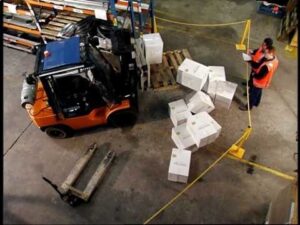June
Conduction Thorough Accident Investigations: A Guide for Management and Supervisors
Accident investigations are a crucial component of maintaining a safe and efficient manufacturing environment. As a manager or supervisor, it is your responsibility to ensure that accidents are investigated thoroughly and that appropriate measures are taken to prevent future occurrences. This article will discuss the most important aspects of accident investigation and provide guidance on how to conduct a comprehensive analysis. To better illustrate the process, we will use a specific example throughout the article.
Example: An employee, John, falls from a storage rack while attempting to retrieve a part, sustaining a back injury. The incident occurs on a Tuesday afternoon in the warehouse section of the manufacturing facility.
Step 1 – Respond promptly and prioritize safety
When the accident occurs, the supervisor, Sarah, immediately calls for medical assistance and rushes to the scene. She ensures that John receives proper medical attention and secures the area to prevent other employees from accessing the racks until the investigation is complete.
Step 2 – Gather information
Sarah begins the investigation by gathering information about the accident. She interviews John and witnesses to understand the circumstances leading up to the incident. Sarah learns that John climbed the rack because the necessary ladder was not available, and he was in a hurry because the order needed to be shipped out. She also takes photos of the storage area and reviews John’s training records to determine if he had received proper training on part retrieval procedures.
Step 3 – Analyze the root cause
Sarah avoids blaming John for the accident and instead focuses on identifying the root cause. It’s important to recognize that simply retraining the injured employee is not sufficient, as it only addresses the issue for that one individual and ignores the fact that other employees could potentially repeat the same mistake. By focusing on the root cause, Sarah aims to identify systemic issues that may affect the entire workforce.
She uses the “5 Whys” technique, which involves asking “why” repeatedly to delve deeper into the underlying factors contributing to the incident. Here’s how Sarah applies the “5 Whys” technique:
- Why #1. Why did John climb the rack? – To retrieve a part.
- Why #2. Why didn’t John use a ladder? – The ladder was not available.
- Why #3. Why was the ladder not available? – It was being used in another area of the facility and wasn’t returned to its proper place.
- Why #4. Why wasn’t there a spare ladder? – The company had not purchased additional ladders.
- Why #5. Why hadn’t the company purchased additional ladders? – There was no system in place to identify and address equipment shortages.
By using this technique, Sarah discovers that the root causes extend beyond John’s individual actions and involve broader issues such as equipment availability and the lack of a system to identify and address shortages. Addressing these systemic problems will help prevent similar accidents from occurring in the future, regardless of which employee is involved.
Step 4 – Develop corrective actions
Based on the root cause analysis, Sarah develops a set of corrective actions:
- Purchase additional ladders to ensure availability throughout the facility.
- Implement a system for employees to report equipment shortages or maintenance needs.
- Retrain all employees on proper procedures for retrieving parts and the importance of using ladders.
- Evaluate storage rack layout to identify opportunities for improvement, such as reducing the need for employees to access higher levels.
- Review and update safety policies and procedures based on the findings of the investigation.
Step 5 – Implement and communicate changes
Sarah communicates the corrective actions to upper management, who approves the purchase of additional ladders and the implementation of an equipment request system. Sarah then organizes retraining sessions for all warehouse employees, emphasizing the importance of using ladders and avoiding climbing on racks. She also works with the facilities team to evaluate and optimize the storage rack layout.
Step 6 – Monitor and evaluate
In the months following the accident, Sarah conducts regular safety audits to ensure that employees are using ladders correctly and that equipment shortages are being reported and addressed promptly. She also tracks accident rates and near-misses to measure the effectiveness of the implemented changes. The company notices a significant reduction in accidents and near-misses related to improper part retrieval.
By following this thorough accident investigation process, Sarah and the company were able to identify the root cause of John’s accident and implement effective corrective actions. This not only helped prevent future occurrences of similar accidents but also fostered a culture of safety and continuous improvement within the organization.
Remember, the goal of an accident investigation is not to assign blame but to identify opportunities for improvement. By conducting thorough investigations, implementing effective corrective actions, and sharing lessons learned with the entire organization, you can create a safer work environment for all employees and demonstrate your commitment to their well-being.

